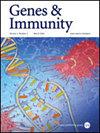Characterizing the immune landscape of tumor-infiltrating lymphocytes in non-small cell lung cancer
IF 4.5
3区 医学
Q1 GENETICS & HEREDITY
引用次数: 0
Abstract
Tumor-Infiltrating Lymphocytes (TILs) immunotherapy is a highly promising treatment for Non-small Cell Lung Cancer (NSCLC), which is responsible for 18% of all cancer-related deaths. The heterogeneity of TILs remains poorly understood. Here, we utilized combined single-cell RNA (scRNA)/T cell receptor sequencing (scTCR-seq) data from lung adenocarcinoma (LUAD) patients. Naïve CD4+ and effector memory CD8+ T cells were increased in tumor tissue compared with circulating blood samples. Activated signaling pathways were detected, and GZMA was identified as a potential novel diagnostic biomarker. During the transitional phase, macrophages (FTL) and dendritic (AIF1) cells transported the most CD3 TCR clones to T cells, while cytotoxicity CD8+ T (NKG7) cells transported to terminal exhausted CD8+ T cells. In both transition and expansion phases, T helper cells (CXCL13) are transported to regulatory T cells (Tregs). Additionally, we investigated the expression profiles of key cytokines, checkpoint receptors, and their ligands. Cytotoxicity CD8+ T cells (CCL5 and IFNG), T helper cells (FTL, TNFRSF4, and TIGIT), and regulatory T cells (CTLA4, TIGIT and FTL) exhibited functional roles in both primary and metastatic tumor stages. Taken together, our study provides a single-cell resolution of the TIL immune landscape and suggests potential treatment strategies to overcome drug resistance.

非小细胞肺癌肿瘤浸润淋巴细胞的免疫景观特征
肿瘤浸润淋巴细胞(til)免疫疗法是非小细胞肺癌(NSCLC)的一种非常有前途的治疗方法,非小细胞肺癌占所有癌症相关死亡的18%。til的异质性仍然知之甚少。在这里,我们利用肺腺癌(LUAD)患者的单细胞RNA (scRNA)/T细胞受体测序(scTCR-seq)数据。Naïve与循环血液样本相比,肿瘤组织中CD4+和效应记忆CD8+ T细胞增加。激活的信号通路被检测到,GZMA被确定为潜在的新型诊断生物标志物。在过渡阶段,巨噬细胞(FTL)和树突状细胞(AIF1)将最多的CD3 TCR克隆转运到T细胞,而细胞毒性CD8+ T细胞(NKG7)则转运到末端耗尽的CD8+ T细胞。在过渡期和扩增期,T辅助细胞(CXCL13)被转运到调节性T细胞(Tregs)。此外,我们还研究了关键细胞因子、检查点受体及其配体的表达谱。细胞毒性CD8+ T细胞(CCL5和IFNG)、T辅助细胞(FTL、TNFRSF4和TIGIT)和调节性T细胞(CTLA4、TIGIT和FTL)在原发性和转移性肿瘤阶段均表现出功能作用。综上所述,我们的研究提供了TIL免疫景观的单细胞分辨率,并提出了克服耐药性的潜在治疗策略。
本文章由计算机程序翻译,如有差异,请以英文原文为准。
求助全文
约1分钟内获得全文
求助全文
来源期刊

Genes and immunity
医学-免疫学
CiteScore
8.90
自引率
4.00%
发文量
28
审稿时长
6-12 weeks
期刊介绍:
Genes & Immunity emphasizes studies investigating how genetic, genomic and functional variations affect immune cells and the immune system, and associated processes in the regulation of health and disease. It further highlights articles on the transcriptional and posttranslational control of gene products involved in signaling pathways regulating immune cells, and protective and destructive immune responses.
 求助内容:
求助内容: 应助结果提醒方式:
应助结果提醒方式:


